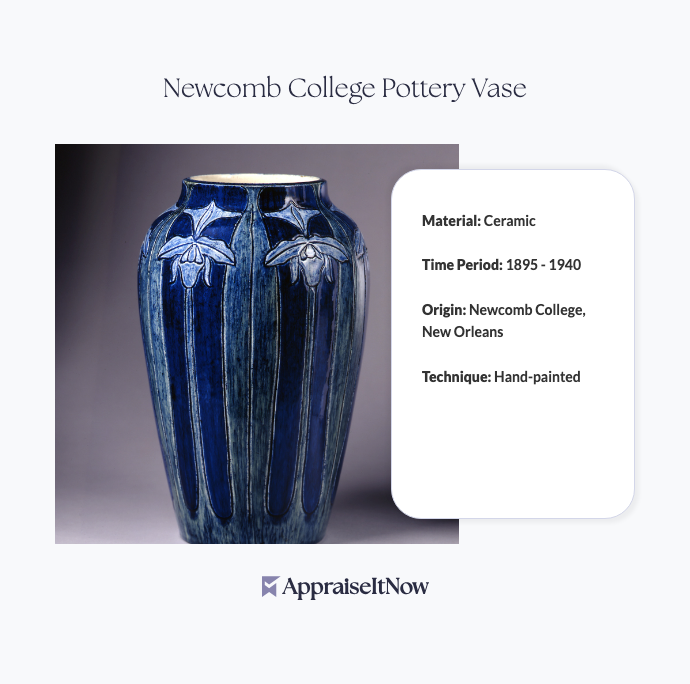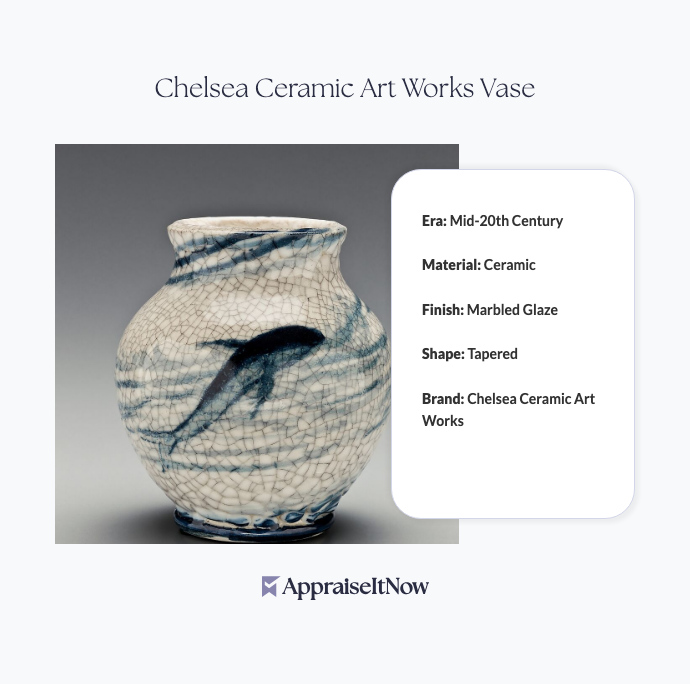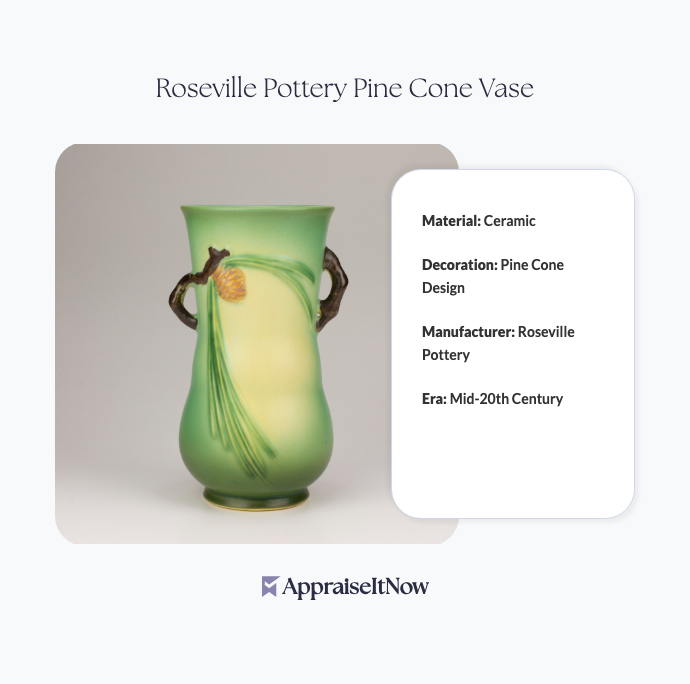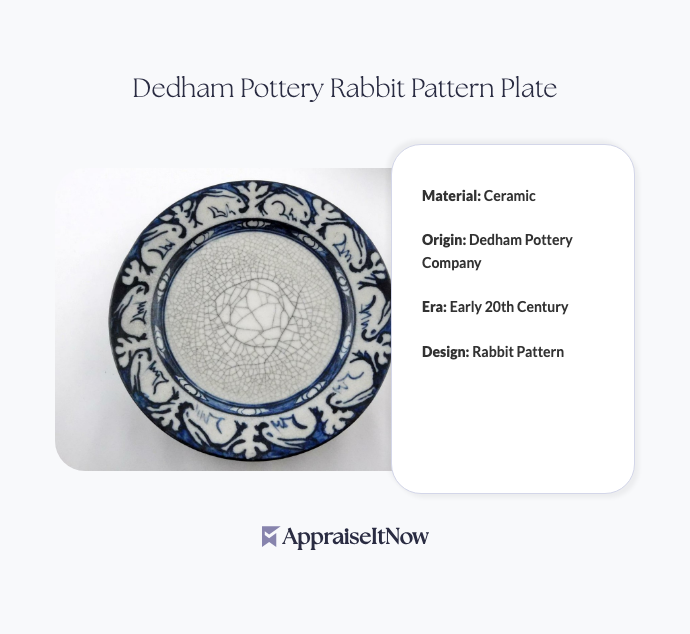<h1>How to Get Your Newcomb College Pottery Vase Appraised</h1>
<p>Your Newcomb College Pottery Vase represents far more than a decorative object—it's a documented piece of American art history and a valuable collectible worth anywhere from <strong>$3,500 to $5,000</strong> depending on condition, design, and provenance. Whether you've inherited a vase, discovered one at an estate sale, or are considering a purchase, understanding how to properly appraise this significant piece ensures you have accurate documentation for insurance, sale, or collection purposes.</p>
<h2>Understanding What Makes Your Newcomb Pottery Valuable</h2>
<p>Newcomb College Pottery vases occupy a unique position in American ceramics history. Created between 1895 and 1940 by students and faculty of the Newcomb Craft School in New Orleans, these hand-painted vessels represent one of the first formal art education programs for women in the United States. This pioneering role, combined with exceptional artistic merit, drives sustained collector demand and appreciation.</p>
<p>What gives your Newcomb vase its value? The answer lies in the convergence of several factors. First, the vases were produced in limited quantities, making scarcity a primary value driver. Second, each piece featured hand-painted designs—typically depicting local flora including magnolias, irises, and other plants reflecting the Gulf Coast's lush environment. Third, the production process involved specialized techniques using local Louisiana clays and distinctive glazing methods that created visual depth and durability. These elements combine to create objects that serious collectors actively seek for both <a href="/types/artwork">artwork</a> and <a href="/types/memorabilia-and-collectibles">memorabilia and collectibles</a> portfolios.</p>
<p>When asking "What is Newcomb Pottery?", you're essentially asking about an important chapter in American decorative arts where artistic innovation merged with educational mission. The Newcomb program elevated ceramics beyond functional tableware into fine art territory, and today's market recognizes this distinction through valuations that have appreciated substantially over decades.</p>
<div class="callout tip"><p><strong>Collector's Insight</strong></p>
<p>Newcomb College vases with particularly striking or rare floral designs command 20-30% premiums over standard examples, making design documentation essential during appraisal.</p></div>
<h2>Identifying Authentic Newcomb College Pieces</h2>
<p>Before seeking professional appraisal, you should understand how to identify authentic Newcomb pottery, as this directly impacts whether an appraisal is worthwhile and what value it might reveal. The question "How do I identify Newcomb Pottery?" has several practical answers that appraisers use to verify authenticity.</p>
<p>Genuine Newcomb vases feature distinct marking systems. Examine the bottom of your piece for maker's marks, which typically include the "NC" cipher (the intertwined letters) along with artist initials and sometimes pattern numbers. These marks distinguish authentic Newcomb pieces from reproductions or similar pottery from competing art schools. The base should also show evidence of hand-finishing and may contain slight imperfections—a hallmark of hand-thrown ceramics rather than industrial production.</p>
<p>The glaze itself tells a story. Newcomb pottery displays characteristic matte finishes in soft, muted color palettes featuring blues, greens, grays, and earth tones. This represents a deliberate artistic choice reflecting Arts and Crafts movement philosophy. Unlike glossy commercial ceramics, your vase should have a slightly textured, velvety surface that feels distinctive to the touch.</p>
<p>The form and decoration provide additional authentication clues. Newcomb designs show remarkable consistency in style while maintaining individual artistic variation. Painted imagery typically appears hand-executed with slight variation in line weight and color application—what collectors call "artist's hand." Computer-generated or artificially regular patterns suggest reproduction pieces rather than authentic Newcomb work.</p>
<div class="callout note"><p><strong>Authentication Detail</strong></p>
<p>The presence of the artist's initials on the bottom, combined with proper NC markings and period-appropriate glazing, provides strong evidence of authenticity that professional appraisers verify during evaluation.</p></div>
<h2>Factors That Determine Your Vase's Specific Value</h2>
<p>While the general market range sits at <strong>$3,500 to $5,000</strong>, your individual piece may fall higher or lower depending on specific characteristics. Understanding these value drivers helps you prepare documentation for a professional appraisal and ensures you're comparing your vase accurately to market comparables.</p>
<p><strong>Size and form variations</strong> significantly impact pricing. Smaller vases under six inches typically command lower valuations than larger forms, which showcase more extensive hand-painted decoration and required greater skill to execute. Baluster forms, cylinder shapes, and other classic Newcomb shapes typically perform better than unusual or experimental forms, though rare forms occasionally attract premium prices from advanced collectors.</p>
<p><strong>Artistic quality and design significance</strong> represent the most subjective but powerful value factor. Vases featuring botanically accurate renderings of native Louisiana flora—particularly those showing exceptional skill in depicting light, shadow, and botanical detail—command premium pricing. Designs by particularly celebrated Newcomb artists, when identifiable through signature marks, increase values substantially. Historical documentation noting specific awards or exhibitions adds considerable value for collectors and institutions alike.</p>
<p><strong>Condition assessment</strong> directly translates to monetary value. Professional appraisers for ceramics examine pieces under various lighting to identify chips, cracks, restoration work, or glaze issues. Small surface marks and age-appropriate patina typically don't significantly reduce value, but significant damage, extensive restoration, or structural compromise substantially diminishes worth. Unlike some antiques that benefit from visible age, ceramics lose value more precipitously with damage, as restoration becomes visually obvious.</p>
<p><strong>Production period</strong> creates natural valuation tiers. Vases from the earlier years (1895-1910) generally command higher prices than later examples, with 1920s-1940s pieces representing the most accessible entry point for new collectors. Early pieces often display bolder, more distinctive designs, while later production sometimes shows more conservative imagery as market preferences shifted.</p>
<h2>Preparing for Professional Appraisal</h2>
<p>To obtain an accurate, defensible appraisal of your Newcomb College Pottery Vase, proper preparation maximizes the appraiser's ability to document and value your piece effectively.</p>
<p><strong>Gather historical documentation</strong> before your appraisal appointment. If you know your vase's provenance—where it was acquired, previous ownership, any exhibition history—document these details. Family correspondence, auction house catalogs, or insurance records from previous owners all contribute valuable context. For pieces inherited from estates, research the original owner's interests and collecting focus, as this context influences value assessment.</p>
<p><strong>Document the piece thoroughly with photography</strong>. Take clear photographs of multiple angles including the decorated surface, base markings, any artist signatures, and overall form. Photograph under natural light as well as indoor lighting to show how the glaze appears under different conditions. High-quality images help professional appraisers make preliminary assessments and create detailed appraisal documentation suitable for insurance purposes.</p>
<p><strong>Note any markings or maker's information</strong> visible on the base. The placement and clarity of the NC mark, artist initials, and any pattern numbers directly influence authenticity assessment. Some Newcomb pieces include painted numerical codes underneath the glaze that specialists decode to identify specific artists and production dates. Don't attempt to clean or clarify marks—present the vase exactly as you possess it, allowing the appraiser to assess condition accurately.</p>
<p><strong>Compile any published references</strong> mentioning your specific piece. Newcomb pottery has been extensively documented in specialized books and museum catalogs. If your vase appears in published works or exhibition records, this documentation dramatically strengthens valuation and increases appeal to serious collectors.</p>
<h2>When to Seek Professional Appraisal</h2>
<p>You should obtain professional appraisal when several scenarios apply. If you're selling your Newcomb vase—whether through auction, private sale, or dealer consultation—a certified appraisal establishes fair market value and provides credibility in negotiations. Insurance companies increasingly require independent appraisals for decorative <a href="/types/antique-artwork">antique artwork</a> valued above certain thresholds, making professional documentation essential for coverage.</p>
<p>Estate planning and inheritance situations often demand formal valuations for tax purposes or equitable distribution among heirs. Museum donations require certified appraisals documenting fair market value for tax deduction purposes. Even collectors simply seeking to understand their collection's worth benefit from periodic professional reassessment, as market values for Newcomb pottery have demonstrated consistent appreciation over time.</p>
<p>Appraisers specializing in <a href="/blog/appraisals-for-fine-porcelain-and-ceramics-valuing-delicate-artistry">fine porcelain and ceramics</a> bring expertise that distinguishes genuine Newcomb pieces from similar pottery produced by competing art schools or contemporary commercial manufacturers. This specialized knowledge directly impacts valuation accuracy and the credibility of your appraisal documentation.</p>
<h2>How Newcomb Pottery Values Have Evolved</h2>
<p>Understanding market trends provides context for your appraisal. Newcomb College pottery has demonstrated remarkable market appreciation over recent decades. In the 1980s, quality vases typically sold for $500-1,000 at auction. By the 2000s, prices had reached $1,500-3,000 for good examples. Today's market reflects <strong>$3,500-5,000</strong> valuations for quality pieces, representing substantial appreciation driven by growing recognition of the Newcomb program's historical importance and the aesthetic appeal of Arts and Crafts ceramics to contemporary collectors.</p>
<p>This appreciation trajectory mirrors broader trends in American decorative arts where institutional validation through museum acquisitions and scholarly attention drives collector interest. As more museums have added Newcomb pieces to their collections, public awareness has grown, expanding the collector base and supporting stronger prices. Your appraisal should reflect current market conditions while noting this appreciation history, which provides confidence in the valuation's appropriateness.</p>
<div class="callout tip"><p><strong>Market Perspective</strong></p>
<p>Newcomb pottery values have historically appreciated 3-5% annually over the past two decades, making these pieces solid alternatives to traditional investment strategies for collectors who also value aesthetic enjoyment.</p></div>
<h2>Understanding the Appraisal Scope and Documentation</h2>
<p>When you receive your appraisal, expect comprehensive documentation explaining the value conclusion. Professional appraisals following USPAP (Uniform Standards of Professional Appraisal Practice) standards include detailed descriptions of the piece, condition assessment, relevant market data, and the methodology used to reach the valuation. This documentation becomes essential for insurance coverage, providing claims adjusters with detailed information should loss or damage occur.</p>
<p>Your appraiser will photograph your vase in high resolution, documenting markings, condition details, and overall appearance. This creates a permanent record valuable for insurance purposes and future reference. The appraisal will note dimensions, weight, materials, construction techniques, condition issues, and any restoration work—elements that directly influence value assessment and insurance replacement decisions.</p>
<p>For pieces with significant values, appraisers should explain comparable sales data supporting the valuation conclusion. This demonstrates that the appraiser has researched recent market transactions and based conclusions on objective market evidence rather than speculation. Understanding how your vase compares to recently sold examples helps you appreciate why it commands its specific market value.</p>
<h2>Building Your Appraisal Documentation Strategy</h2>
<p>To maximize the professional appraisal's value for your purposes, clarify the appraisal's intended use when engaging an appraiser. Insurance appraisals emphasize replacement cost and detailed condition documentation. Estate and tax appraisals require different emphasis on fair market value and support for conclusions. Auction house appraisals focus on competitive positioning and recent comparable sales.</p>
<p>Connect with appraisers experienced in American decorative arts and specifically familiar with Newcomb College pottery. Generalist appraisers may struggle to identify significant characteristics and may undervalue pieces by missing design significance or production period implications. Specialists in this field understand the nuanced market factors affecting Newcomb vases and can provide valuations reflecting authentic collector demand.</p>
<p>AppraiseItNow connects you with certified appraisers specializing in <a href="/blog/appraising-antiques-unveiling-the-hidden-treasures-in-your-collection">antiques and collectibles</a> including fine ceramics and pottery pieces. Our platform allows you to submit photographs, descriptions, and documentation securely online, with responses from credentialed experts across the U.S. holding credentials from AAA, ISA, ASA, CAGA, and AMEA—the major appraiser certification organizations.</p>
<div class="callout note"><p><strong>Key Takeaway</strong></p>
<p>A certified appraisal of your Newcomb College Pottery Vase provides the accurate valuation, detailed documentation, and professional credibility essential for insurance protection, confident selling decisions, or estate planning purposes. This investment in professional expertise ensures your collectible receives appropriate recognition and protection in today's marketplace.</p></div>







.avif)







